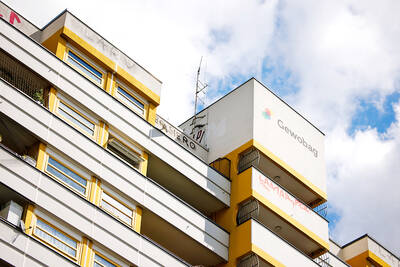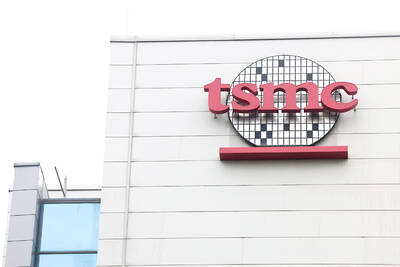Around this time every year, Moroccan wheat farmer Abderrahim Mohafid is usually preparing for his spring harvest, but this year his fields lie unusually bare.
On the road leading up to his hamlet in Berrechid province, Morocco’s historical breadbasket about 40km southeast of Casablanca, vast fields languish as the country grapples with its sixth consecutive year of drought.
“The harvest is already lost,” said Mohafid, 54, as he glanced at his 20-hectare field where almost nothing has grown. “Wheat should already be at 60 centimeters.”

Photo: AFP
In a neighboring village, Hamid Najem found himself in the same predicament.
His 52 hectares that have yielded soft wheat and barley in past years “are no longer good for anything,” the 50-year-old said. “We’ve never had such a tough year.”
More than 88 percent of Berrechid’s vast agricultural lands are not irrigated, with farmers relying instead on rain, according to Morocco’s agriculture ministry.

Photo: AFP
Yet so far this year, the North African country has seen only about half the rainfall it did during the same period last year, Moroccan Minister of Equipment and Water Nizar Baraka said.
This has occurred in parallel with temperatures in Morocco increasing by an average of 1.8 degrees Celsius compared with the period between 1981 and 2010, he added.
In recent weeks, Moroccan authorities have restricted the opening of hammams and car wash stations in several cities and prohibited the watering of golf courses or gardens with drinking water, as the country’s dams are only at 23 percent capacity, compared with around 32 percent last year.
The successive years of drought are “compromising” this agricultural season, agronomist Abderrahim Handouf said.
Fearing the effects of the prolonged water scarcity, farmers had already reduced the size of areas in which they sowed cereals, according to the expert.
In November last year, they had sown 2.3 million hectares compared to between 4 million and 5 million hectares on average in previous years, he said.
The situation, Handouf added, will have a “serious impact on the economy” of the country where a third of the population works in agriculture.
The sector also accounts for 14 percent of Morocco’s exports, with exported produce seen as more profitable than that sold in domestic markets.
Mohafid said he hoped to make up for losses in previous seasons by adapting new sowing techniques, such as planting seeds without plowing the field first, allowing the soil to preserve its natural humidity.
“The harvest is already lost, but I hope it will rain in February and March at least to have enough to feed the livestock,” he said.
For some larger-scale farmers, the prospects aren’t as gloomy, but irrigation has become essential.
Hamid Mechaal said he can count on irrigation to save his 140 hectares in the east of the province of Berrechid, where he grows wheat, carrots and potatoes.
“With drought, we are forced to irrigate at 85 percent, whereas before, irrigation was only complementary,” the farmer said.
Like 500 farmers in the region, he is supplied with a fixed allocation of 5,000 tonnes of water per hectare “to better manage” the coveted resource.
Morocco’s agricultural model — tunnel-visioned on exports for the past 15 years — is yet again faced with challenges at a time when the country sees “an absolutely declining water supply,” agronomist Mohamed Taher Srairi said.
It has nonetheless been focused on water-intensive crops, like carrots in Berrechid, he added.
The Food and Agriculture Organization (FAO) has similarly warned of a “disorderly intensification of irrigation” in Berrechid over the past two decades.
“Between 2007 and 2017, carrot production, for instance, increased nearly 500 percent,” the FAO said in a report in November last year, adding that the Berrechid aquifer was “one of the most depleted in Morocco.”
The North African country’s needs are estimated at more than 16 billion cubic meters of water, including 87 percent for the agricultural sector, but it has only had five billion cubic meters over the last five years, according to the water ministry.
“Agricultural policy should be reviewed from top to bottom,” Handouf said. “Today, I’m under the impression that the government is looking in one direction while reality is in the opposite direction.”

When an apartment comes up for rent in Germany’s big cities, hundreds of prospective tenants often queue down the street to view it, but the acute shortage of affordable housing is getting scant attention ahead of today’s snap general election. “Housing is one of the main problems for people, but nobody talks about it, nobody takes it seriously,” said Andreas Ibel, president of Build Europe, an association representing housing developers. Migration and the sluggish economy top the list of voters’ concerns, but analysts say housing policy fails to break through as returns on investment take time to register, making the

EARLY TALKS: Measures under consideration include convincing allies to match US curbs, further restricting exports of AI chips or GPUs, and blocking Chinese investments US President Donald Trump’s administration is sketching out tougher versions of US semiconductor curbs and pressuring key allies to escalate their restrictions on China’s chip industry, an early indication the new US president plans to expand efforts that began under former US president Joe Biden to limit Beijing’s technological prowess. Trump officials recently met with their Japanese and Dutch counterparts about restricting Tokyo Electron Ltd and ASML Holding NV engineers from maintaining semiconductor gear in China, people familiar with the matter said. The aim, which was also a priority for Biden, is to see key allies match China curbs the US

NOT TO WORRY: Some people are concerned funds might continue moving out of the country, but the central bank said financial account outflows are not unusual in Taiwan Taiwan’s outbound investments hit a new high last year due to investments made by contract chipmaker Taiwan Semiconductor Manufacturing Co (TSMC, 台積電) and other major manufacturers to boost global expansion, the central bank said on Thursday. The net increase in outbound investments last year reached a record US$21.05 billion, while the net increase in outbound investments by Taiwanese residents reached a record US$31.98 billion, central bank data showed. Chen Fei-wen (陳斐紋), deputy director of the central bank’s Department of Economic Research, said the increase was largely due to TSMC’s efforts to expand production in the US and Japan. Investments by Vanguard International

STRUGGLING TO SURVIVE: The group is proposing a consortium of investors, with Tesla as the largest backer, and possibly a minority investment by Hon Hai Precision Nissan Motor Co shares jumped after the Financial Times reported that a high-level Japanese group has drawn up plans to seek investment from Elon Musk’s Tesla Inc to aid the struggling automaker. The group believes the electric vehicle (EV) maker is interested in acquiring Nissan’s plants in the US, the newspaper reported, citing people it did not identify. The proposal envisions a consortium of investors, with Tesla as the largest backer, but also includes the possibility of a minority investment by Hon Hai Precision Industry Co (鴻海精密) to prevent a full takeover by the Apple supplier, the report said. The group is